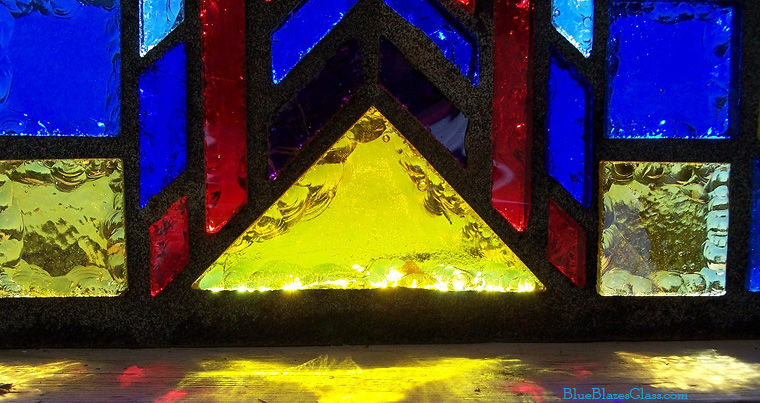The use of thick glass to make stained glass windows was revived in France in the 1920s. Most sources attribute the first piece to Auguste Labouret. Until the 1950s, the glass was held together with concrete. Concrete expands and contracts at a different rate than glass, and these windows had a tendency to fall apart over time. In the 1950s, epoxies matching the coefficient of expansion of glass were developed, greatly improving the lifetime of the windows. (Note 1)
Most artists to-date have cut and shaped dalle de verre using a chisel with a carbide tip and a hardie. A hardie is a pointed anvil. (See Note 2)
The advantage of this technique is a clean shiny cut in the glass. The disadvantage is the technique can generate big piles of mistakes and shards, especially for beginners. I prefer the control of a wetsaw. (Note 3) The disadvantage of a wetsaw is it creates silica dust, which is a serious health hazard if you are not very careful about wearing a high quality mask and gloves. You must either use a wet process for cleanup (no sweeping!) or use a shop vacuum with a HEPA filter (and then be very careful how you clean your filter!).
The slabs are normally about 1" (25cm) thick, 8" x 12" (20 x 30 cm) (more on dalle de verre versus regular stained glass). The two primary sources for glass are Blenko ( https://blenko.com/ ) and Kokomo ( https://www.kog.com ). Blenko has a wide variety of colors but stopped providing sample packs. You can find dalle de verre under Architectural on their website.
Kokomo has less colors, but the colors are full of life and they offer sample packs. Kokomo is a pleasure to deal with.
Next you need a mold where you can place the dalle de verre and pour epoxy in the gaps. This mold can be as simple as 1x2s screwed onto a stiff piece of plywood. The epoxy needs to cure for a week to reach full strength. I use stiff, reinforced plywood for the base of the mold. If you don't want to make windows with straight edges, then you can cut a mold from another layer of plywood or from insulation board (foam core--cuts easily with a jigsaw with a knife blade). However, the epoxy bonds well to plywood! I line the inside of the mold with duct tape and tack a layer of wax paper onto the base before mounting the mold. The duct tape and wax paper must be coated with something to prevent the epoxy from bonding. I've been using car wax. The epoxy seems thick, but it will find and penetrate any little separation between the base and the mold. Caulk the joint before applying the mold release (wax). Use fast drying caulk if you don't want to waste a day waiting for the caulk to dry.
Want to know more? Feel free to contact me.
The following two sites have not gone to https so I can only reference the main body of their URLs.
Note 1: keyresin.com Ask for: Key #116 Slab Glass Epoxy. Unfortunately they don't seem to list it on their website.
Note 2: I started out with a low cost tilesaw from Harbor Freight for a few hundred dollars. Now I do much of my cutting on a Gemini Revolution ring saw. geminisaw.com/revolutionxt.html
There are several videos on that page, with links to more on YouTube.


